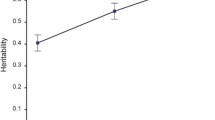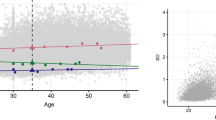Abstract
We examined shared and distinct genetic influences among standard measures of pulmonary functions: ratio of forced expiratory volume at 1 s to forced vital capacity (FEV1/FVC) and percent predicted values for forced expiratory volume at 1 s (FEV1%p), forced expiratory flow (FEFmax%p), and maximal voluntary ventilation (MVV%p) in 978–1,048 middle-aged (mean age = 55 years) male–male twins from the Vietnam Era Twin Study of Aging. A common latent factor (h2 = 0.30) accounted for the correlations among these measures. This factor accounted for 54–81 % of the heritability of FEV1%p, FEFmax%p and MVV%p, but only explained 16 % of the heritability of FEV1/FVC. The remaining heritability of FEV1/FVC was explained by genetic influences independent of the common factor. Our findings suggest that while a common latent phenotype accounts for the relationships among different pulmonary function measures, the majority of genetic influences underlying FEV1/FVC—an index of pulmonary obstruction—are distinct from those underlying other pulmonary function measures.


Similar content being viewed by others
References
Aldrich T, Arora N, Rochester D (1982) The influence of airway obstruction and respiratory muscle strength on maximal voluntary ventilation in lung disease. Am Rev Respir Dis 126(2):195
Balfe DL, Lewis M, Mohsenifar Z (2002) Grading the severity of obstruction in the presence of a restrictive ventilatory defect. Chest 122(4):1365–1369
Barreiro TJ, Perillo I (2004) An approach to interpreting spirometry. Am Fam Physician 69(5):1107–1116
Bass H (1973) The flow volume loop: normal standards and abnormalities in chronic obstructive pulmonary disease. Chest 63(2):171–176
Boomsma D, Busjahn A, Peltonen L (2002) Classical twin studies and beyond. Nat Rev Genet 3(11):872–882
Boren HG, Kory RC, Syner JC (1966) The veterans administration-army cooperative study of pulmonary function. II The lung volume and its subdivisions in normal men. Am J Med 41(1):96–114
Center for Disease Control and Prevention (2003) Public health and aging: trends in aging—United States and worldwide. MMWR CDC Surveill Summ 52:101–106
Chatterjee S, Das N (1995) Lung function in Indian twin children: comparison of genetic versus environmental influence. Ann Hum Biol 22(4):289–303
Chen Y (1999) Genetics and pulmonary medicine. 10: genetic epidemiology of pulmonary function. Thorax 54(9):818
Chyou PH, White LR, Yano K, Sharp DS, Burchfiel CM, Chen R, Rodriguez BL, Curb JD (1996) Pulmonary function measures as predictors and correlates of cognitive functioning in later life. Am J Epidemiol 143(8):750–756
Eisen S, True W, Goldberg J, Henderson W, Robinette CD (1987) The Vietnam Era Twin (VET) Registry—method of construction. Acta Genet Med Gemellol 36(1):61–66
Gibson P, Simpson J (2009) The overlap syndrome of asthma and COPD: what are its features and how important is it? Thorax 64(8):728–735
Henderson WG, Eisen S, Goldberg J, True WR, Barnes JE, Vitek ME (1990) The Vietnam Era Twin Registry: a resource for medical research. Public Health Rep 105(4):368–373
Hukkinen M, Kaprio J, Broms U, Viljanen A, Kotz D, Rantanen T, Korhonen T (2011) Heritability of lung function: a twin study among never-smoking elderly women. Twin Res Hum Genet 14(5):401
Ingebrigtsen TS, Thomsen SF, van der Sluis S, Miller M, Christensen K, Sigsgaard T, Backer V (2011) Genetic influences on pulmonary function: a large sample twin study. Lung Epub had a print
Kaseda S, Aoki T, Hangai N, Shimizu K (2000) Better pulmonary function and prognosis with video-assisted thoracic surgery than with thoracotomy. Ann Thorac Surg 70(5):1644–1646
Knudson RJ, Slatin R, Lebowitz M, Burrows B (1976) The maximal expiratory flow-volume curve. Normal standards, variability, and effects of age. Am Rev Respir Dis 113(5):587
Kremen W, Thompson-Brenner H, Leung Y, Grant M, Franz C, Eisen S, Jacobson K, Boake C, Lyons M (2006) Genes, environment, and time: the Vietnam Era Twin study of Aging (VETSA). Twin Res Hum Genet 9(6):1009–1022
Lebecque P, Kiakulanda P, Coates A (1993) Spirometry in the asthmatic child: is FEF25–75 a more sensitive test than FEV1/FVC? Pediatr Pulmonol 16(1):19–22
Mannino DM, Homa DM, Akinbami LJ, Ford ES, Redd SC (2002) Chronic obstructive pulmonary disease surveillance-United States, 1971–2000. Respir care 47(10):1184–1199
Marcus EB, Curb JD, MacLean CJ, Reed DM, Yano K (1989) Pulmonary function as a predictor of coronary heart disease. Am J Epidemiol 129(1):97–104
McClearn GE, Svartengren M, Pedersen NL, Heller DA, Plomin R (1994) Genetic and environmental influences on pulmonary function in aging Swedish twins. J Gerontol 49(6):M264
McFadden E, Linden DA (1972) A reduction in maximum mid-expiratory flow rate: a spirographic manifestation of small airway disease. Am J Med 52(6):725–737
Miller MR, Hankinson J, Brusasco V, Burgos F, Casaburi R, Coates A, Crapo R, Enright P, Van Der Grinten C, Gustafsson P (2005) Standardisation of spirometry. Eur Respir J 26(2):319–338
National Center for Disease Statistics (2003) U.S. Department of Health and Human Services, Centers for Disease Control and Prevention. Hyattsville, MD
Neale MC, Boker S, Xie G, Maes HH (2004) Mx: statistical modeling. In: Virginia Commonwealth University, Richmond
Pathan SS, Gottesman RF, Mosley TH, Knopman DS, Sharrett AR, Alonso A (2011) Association of lung function with cognitive decline and dementia: the atherosclerosis risk in communities (ARIC) study. Eur J Neurol 18(6):888–898
Pauwels RA (2000) National and international guidelines for COPD—the need for evidence. Chest 117(2):20–22
Pellegrino R, Viegi G, Brusasco V, Crapo R, Burgos F, Casaburi R, Coates A, van der Grinten C, Gustafsson P, Hankinson J (2005) Interpretative strategies for lung function tests. Eur Respir J 26(5):948–968
Plomin R, DeFries J, McClearn G, McGuffin P (2001) Behavior genetics. Worth, New York
Rabe KF, Hurd S, Anzueto A, Barnes PJ, Buist SA, Calverley P, Fukuchi Y, Jenkins C, Rodriguez-Roisin R, van Weel C (2007) Global strategy for the diagnosis, management, and prevention of chronic obstructive pulmonary disease: gold executive summary. Am J Respir Crit Care Med 176(6):532
Schünemann HJ, Dorn J, Grant BJB, Winkelstein W, Trevisan M (2000) Pulmonary function is a long-term predictor of mortality in the general population. Chest 118(3):656–664
Simon, Chinchilli VM, Phillips BR, Sorkness CA, Lemanske RF Jr, Szefler SJ, Taussig L, Bacharier LB, Morgan W (2010) Forced expiratory flow between 25 and 75 % of vital capacity and FEV1/forced vital capacity ratio in relation to clinical and physiological parameters in asthmatic children with normal FEV1 values. J Allergy Clin Immunol 126(3):527–534 e528
So HC, Gui AHS, Cherny SS, Sham PC (2011) Evaluating the heritability explained by known susceptibility variants: a survey of ten complex diseases. Genet Epidemiol 35(5):310–317
Soler Artigas M, Wain LV, Tobin MD (2012) Genome-wide association studies in lung disease. Thorax 67(3):271–273
Tzortzaki EG, Proklou A, Siafakas NM (2011) Asthma in the elderly: can we distinguish it from COPD? J Allergy EPub had a print
Vasilopoulos T, Mack HA, McClearn GE, Berg S, Johansson B, Vogler GP (2010) Stability of genetic influences on pulmonary function in a longitudinal study of octogenarian twins. Am J Hum Biol 22(3):375–377
Wilk JB, Djousse L, Arnett DK, Rich SS, Province MA, Hunt SC, Crapo RO, Higgins M, Myers RH (2000) Evidence for major genes influencing pulmonary function in the NHLBI Family Heart Study. Genet Epidemiol 19(1):81–94
Wilk JB, DeStefano AL, Joost O, Myers RH, Cupples LA, Slater K, Atwood LD, Heard-Costa NL, Herbert A, O’Connor GT (2003) Linkage and association with pulmonary function measures on chromosome 6q27 in the framingham heart study. Hum Mol Genet 12(21):2745
Wu T, Boezen H, Postma D, Los H, Postmus P, Snieder H, Boomsma D (2010) Genetic and environmental influences on objective intermediate asthma phenotypes in Dutch twins. Eur Respir J 36(2):261–268
Acknowledgments
The Cooperative Studies Program of the Office of Research & Development of the United States Department of Veterans Affairs has provided financial support for the development and maintenance of the Vietnam Era Twin (VET) Registry. All statements, opinions, or views are solely of the authors and do not necessarily reflect the position or policy of the Department of Veterans Affairs or the United States government, the NIA, or the NIH. Most importantly, the authors gratefully acknowledge the continued cooperation and participation of the members of the VET Registry and their families. Without their contribution, this research would not have been possible. We also appreciate the time and energy of many staff and students on the VETSA projects. This work was supported by Grants from NIH/NIA (F32AG039954, R01AG018386, R01AG018384, R01AG022381, and R01AG022982). It was also, in part, the result of work supported with resources of the VA San Diego Center of Excellence for Stress and Mental Health.
Author information
Authors and Affiliations
Corresponding author
Additional information
Edited by Deborah Finkel.
Rights and permissions
About this article
Cite this article
Vasilopoulos, T., Grant, M.D., Franz, C.E. et al. Shared and Distinct Genetic Influences Among Different Measures of Pulmonary Function. Behav Genet 43, 141–150 (2013). https://doi.org/10.1007/s10519-012-9582-6
Received:
Accepted:
Published:
Issue Date:
DOI: https://doi.org/10.1007/s10519-012-9582-6




